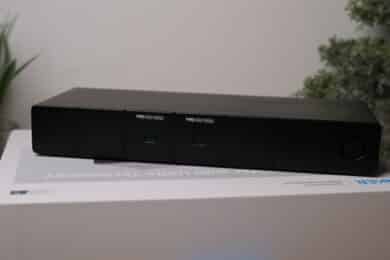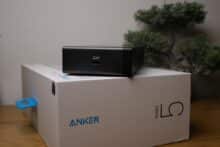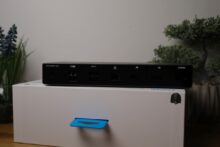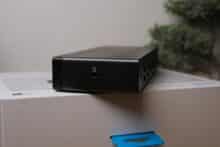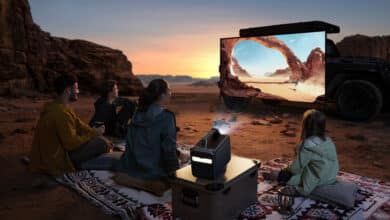
Just a few days ago, Anker introduced a whole series of new docking stations, including the 568, an exciting USB4 solution that wants to score with high speeds and a whole eleven ports. Our Anchor 568 review clarifies whether the purchase is worth it and why I am not completely satisfied.
Technical data
| Model name | Anchor 568 |
| Main Interface | USB4 Type-C |
| USB Type-C ports | 2x USB-C (up to 10 Gbps; 30 watts) |
| USB-A ports | 2x USB 3.0 Type A (up to 5Gbps) 2x USB 2.0 Type A (up to 480 Mbps) |
| Video interfaces | 2x DisplayPort 1.4 (maximum 8K@30 Hz) 1x HDMI 2.0 (maximum 4K@60 Hz) |
| Other interfaces | RJ45 (Gigabit Ethernet) |
| Card reader | not available |
| Power supply | 180 watts |
| Material | Aluminum |
| Operating System Compatibility | Microsoft Windows |
| Weight | 500g (docking station); 535g (power supply) |
| Dimensions (WxDxH) | 209 mm x 79 mm x 32 mm |
| Price | € 55.22 * |

Anchor 568 review: scope of delivery, design and workmanship
- Simple, low-profile design
- Robust, high-quality workmanship
- Comparatively heavy weight; huge power supply
The Anker 568 docking station comes, typical for the manufacturer, in a rather plain white cardboard box, which informs about the most important features. And despite its manageable size, it gives off a decent weight.
It quickly becomes clear why when you open it. In addition to the docking station itself, we find a 180 watt power adapter in the scope of delivery, which is almost as big as the dock itself. Next to it, there is a power cable. A quick-start and complete manual and a USB-C to USB-C cable with 40 Gbit/s.

The design is kept pleasantly simple. The dock itself comes in a light gray finish with the Anker logo in the center of the top. The ports extend over all four sides of the Anker 568 dock, with the front section having a glossy black finish.
Here, on the far right, sits a circular on/off switch, next to a status LED that uses blue to inform you when the dock is on. On the bottom, there are two air vents on the edge and two rubberized feet, as well as two threads for mounting the dock on a monitor, for example.
The build quality is on a very high level, there is nothing to complain about here. However, this is also reflected in the weight. The dock weighs exactly 500 grams and measures 209 mm x 79 mm x 32 mm (width x depth x height). The power adapter is even heavier at 530 grams and almost as wide.
Connections of the Anker 568 and operation
- USB4 port
- No SD card reader; no 3.5mm jack connector
- USB-C ports with charging function up to 30 watts
The Anker 568 docking station in the test is powered via USB4. This is important to know because it is not a Thunderbolt 4 dock. While the two standards have a lot in common, there are a few differences – most notably that USB4 doesn’t HAVE to achieve all the specifications of Thunderbolt 4, but is certainly capable of doing so.
By the way, the docking station is not supposed to be suitable with MacBooks or macOS in general, according to the manufacturer. Why? We don’t know, after all, the current MacBooks also support USB4. According to Anker, however, that should not work here, but there is an almost identical Thunderbolt 4 dock with the Anker 778, which comes up with an additional downstream port.
Enough of the theory. A whole 11 ports can thus be found on the Anker 568, as there are:
- 1x USB4 Type-C Upsteam (maximum 40 Gbit/s and 100 watts)
- 2x USB Type-C (10 Gbit/s and 30 watts)
- 1x Kensington NanoSaver Lock
- 1x power connector (180 watts)
- 2x USB Type-A 2.0 (480 Mbit/s)
- 2x USB Type-A 3.2 Gen 1 (5 Gbit/s)
- 1x Ethernet LAN (1 Gbit/s)
- 2x DisplayPort 1.4 (up to 8K at 30 Hz)
- 1x HDMI 2.0 (up to 4K at 60 Hz)
So, many of the most important connections are given. However, I personally miss two things in particular: there is no SD card reader, which unfortunately disqualifies the docking station for me, and there is no 3.5 mm jack, which again bothers me less – but is repeatedly criticized in various user reviews of Anker docks on Amazon. So you should know that.
In practice, the dock connects to notebooks via USB-C (ideally with the included USB4 cable). I find it a bit unfortunate that the docking station basically takes over the laptop’s power supply.
So, if you want to save a bit of power and run your notebook without a power supply sometimes, you won’t necessarily be happy here. A practical example from me:
I like to use my notebooks without a power supply for not too demanding tasks, but I am dependent on a few additional ports due to the lack of many connections. Especially when it comes to USB-A. With the 568 it is unfortunately not possible to get the ports without constant power supply he.

I also find the positioning of the ports on three sides a bit unattractive. Because besides the power supply (left) and the most important ports (back), the two USB-C ports are found on the front.
Anchor 568 docking station in practical test
- Flawless function in practice
- No coil whine, no dropped connections
- High speeds of the USB ports
In practice, however, the Anker 568 docking station cuts a good figure. During our test, we did not experience any connection drops or problems. I also did not notice any coil rubbing, unlike with the Inter-Tech Argus GDC-802 (our review) – regardless of whether it was during idle, office use or gaming.
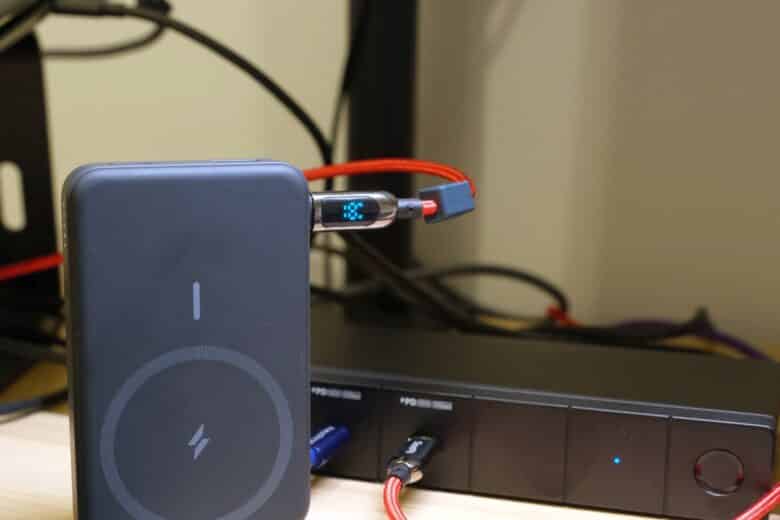
Changing the connected peripherals, connecting and disconnecting the monitor and much more did not pose any particular challenges to the dock and everything worked flawlessly without any errors or disconnections. The dock also achieves the promised 30 watts per port in the charging speed of the two USB-C ports (at peak).
I measured the transfer speed of the USB 3.0 ports on the back with a SanDisk Ultra USB 3.0 stick: Again, there are no notable differences between the notebook and docking station, with sequential read and write speeds nearly identical.
Anker 568 review: conclusion
The Anker 568 docking station leaves a good impression in the test and scores especially with a variety of practical connections that are used on the dock to save space. Thus, several peripherals and monitors can be used simultaneously, which also works flawlessly in practice.
The ports all reach the specified speeds, and there are no connection interruptions. And yet there are a few points that bother me.
On the one hand, I find it a shame that the only two USB-C ports realize a maximum of 10 Gbit/s and the only really fast USB-C port is used to connect the dock and the notebook. On the other hand, I find the design a bit impractical, since the ports on three sides can quickly create a cable tangle.
Personally, I also miss an SD card reader on the docking station, which disqualifies it – at least for my field of application. However, that can certainly still be gotten over for many. On the other hand, the price is comparatively high. With a recommended retail price of around 300 Euros, we are already in the region of Thunderbolt 4 docks that offer more.
In my opinion, this makes it a bit difficult to give the Anker 568 docking station a clear buy recommendation. Although the dock actually works flawlessly and does not have any notable weaknesses. The dock will become more interesting once the price has dropped a bit. Currently, there are almost no reasons to prefer the USB4 docking station over a Thunderbolt dock in my eyes.
Anker 568
Design & workmanship
Compatibility & Connections
Performance & Stability
Value for Money
84/100
The Anker 568 is a convincing USB4 docking station that scores with many ports. However, it lacks important ports and functions, and the price is too high.




